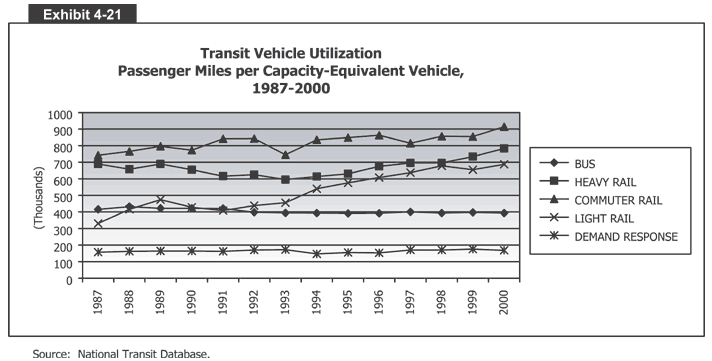U.S. Department of Transportation
Federal Highway Administration
1200 New Jersey Avenue, SE
Washington, DC 20590
202-366-4000
Conditions and Performance
Status
of the Nation's Highways, Bridges, and Transit:
2002 Conditions and Performance Report
|
Exhibit 4-21:
Transit Vehicle Utilization Passenger Miles per Capacity-Equivalent Vehicle,
1987-2000
 Exhibit 4-21 is a chart that shows transit vehicle utilization (TVU) passenger miles per capacity-equivalent vehicle from 1987 to 2000. The vertical axis measures TVU in thousands from 0 to 1,000 in increments of 100 thousand. The horizontal axis measures each year from 1987 to 2000. There are five lines, one for each transit type. The first line, for commuter rail, had the highest TVU; it started at about 720 in 1987, rose to 800 by 1989, dipped to 770 in 1990, rose to 830 in 1991 and 1992, dipped to a low of 720 in 1993, rose to between 810 and 860 between 1994 and 1999, and peaked at 900 in 2000. The next line, for heavy rail, started at about 690 in 1987 and declined gradually to 600 by 1993 before rising gradually to a peak of 780 in 2000. The third line, for light rail, started at about 320 in 1987, rising sharply to 480 in 1989, hovering between 410 and 460 between 1990 and 1993, and finally rising gradually to a peak of about 690 by 2000. The fourth line, for buses, stayed almost completely level at around 400 over the time period. And the fifth line, for demand response, also stayed steady between 140 and 170 between 1987 and 2000.
Exhibit 4-21 is a chart that shows transit vehicle utilization (TVU) passenger miles per capacity-equivalent vehicle from 1987 to 2000. The vertical axis measures TVU in thousands from 0 to 1,000 in increments of 100 thousand. The horizontal axis measures each year from 1987 to 2000. There are five lines, one for each transit type. The first line, for commuter rail, had the highest TVU; it started at about 720 in 1987, rose to 800 by 1989, dipped to 770 in 1990, rose to 830 in 1991 and 1992, dipped to a low of 720 in 1993, rose to between 810 and 860 between 1994 and 1999, and peaked at 900 in 2000. The next line, for heavy rail, started at about 690 in 1987 and declined gradually to 600 by 1993 before rising gradually to a peak of 780 in 2000. The third line, for light rail, started at about 320 in 1987, rising sharply to 480 in 1989, hovering between 410 and 460 between 1990 and 1993, and finally rising gradually to a peak of about 690 by 2000. The fourth line, for buses, stayed almost completely level at around 400 over the time period. And the fifth line, for demand response, also stayed steady between 140 and 170 between 1987 and 2000.
Source: National Transit Database.
Back
to Chapter 4
Return to top
Page last modified on November 7, 2014
